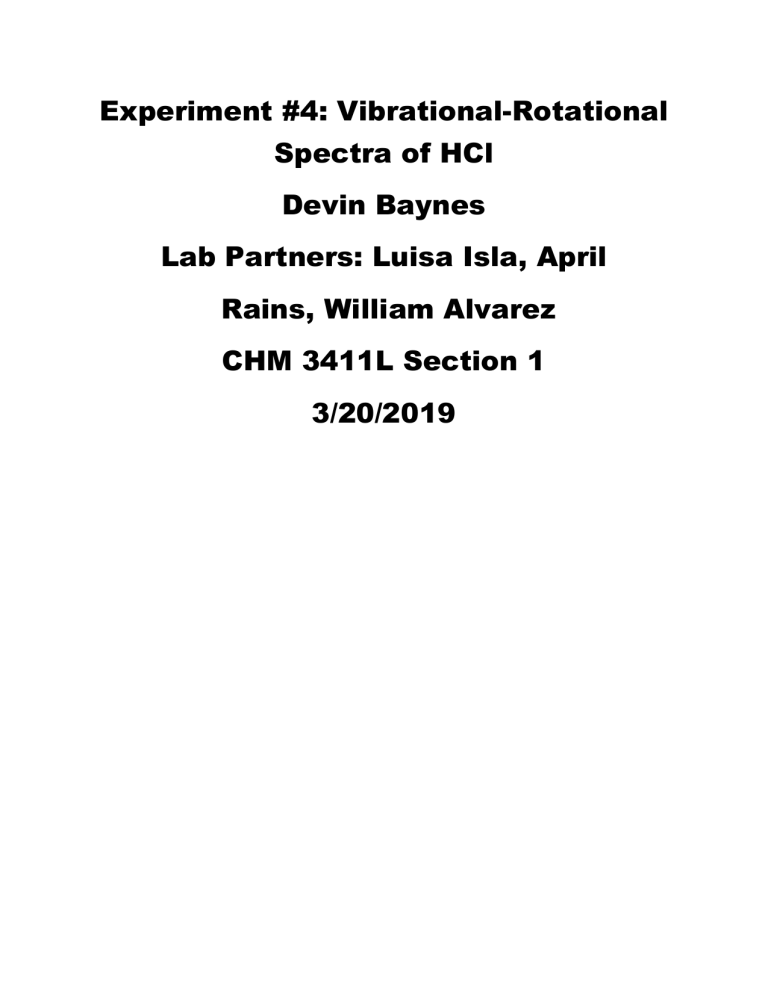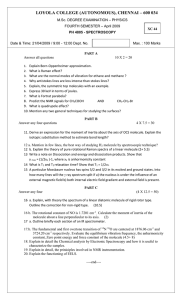
Experiment #4: Vibrational-Rotational Spectra of HCl Devin Baynes Lab Partners: Luisa Isla, April Rains, William Alvarez CHM 3411L Section 1 3/20/2019 Abstract: In this lab the FTIR spectrum was taken of HCl gas and through an analysis of the spectrum the atomic molecular properties were able to be determined. The sample was analyzed and had a ω0 of 2885.4 cm-1, a αe of 0.2828 cm-1, a Be 10.553cm-1, a De of 6.5 x 10-4. From this information the moment of inertia was determined to be 2.652 x 10-47 kg˙m2, and the bond length of the molecule was found to be 1.28 Å. Introduction: The function of the IR gas is to encase the sample during the moment of phase transition while the liquid vaporizes at room temperature within the cell. The spectrophotometer can measure the gas peaks, which are sharper than liquid peaks due to decreased intermolecular interaction. FTIR was used because HCl35 and HCl37 can reach excited vibrational and rotational energy states when exposed to infrared radiation due to the permanent dipole moment on both molecules. Also, the reduced masses of 35Cl and 37Cl are so similar that a highresolution instrument is required to identify where splitting occurs. Therefore, FTIR is used because it is a high-resolution instrument and works quickly to find the absorption of each molecule while having an appropriate spectral range for mid-range infrared measurements as required for HCl35 and HCl37. Also, HCl37 is used in order to induce a difference in the chlorine isotopic, rotational, and vibrational aspects. Peaks are identified by branch, though the forbidden Q branch is not shown as a peak. Rather, it manifests in the absence of a peak between the P and R branches. The absorbance band of a molecule is identified by the zero peak of the R branch. From the vibrational quantum numbers, vibrational frequency, and the planks constant, the energy levels allowed in harmonic oscillator can be determined by using the following equation. 1 𝐸(𝓋) = ℎ𝒱(𝓋 + 2) Here, h is the plank constant, 𝓋 is the vibrational quantum number having integral values 0,1,2…, and 𝒱 is the vibrational frequency. In this experiment the rotational energy of a molecule was also taken to account. The simplest way of explaining the rotational energy of a diatomic molecule is a rigid rotor model where two molecules with different mass rotates around a common center of mass. The atom with heavier mass rotates closer to the center of mass and the atom with lighter mass rotates further from the center of mass. There is a fixed bond length when the rotation occurs. the allowed energy levels for a rigid rotor can be determined by this equation: ℎ2 E(𝐽)=8𝜋2 𝐼 𝐽(𝐽 + 1) Where I stands for moment of inertia and j stands for rotational quantum number. The moment of inertia can be obtained from another equation 𝐼 = 𝑢𝑟 2 where 𝑢 is the reduced mass of the molecules and r is the intermolecular distance. To obtain the total energy of the molecule the one has to take in account both of the vibrational and the rotational energies for this molecule. In order to combine both of the energies, an equation is obtained, T (𝒱, 𝐽) = 𝐸(𝒱,𝐽) ℎ𝑐 1 1 2 = ν̃e(𝒱 + 2) − ν̃exe(𝒱 + 2) + 𝐵𝑒 𝐽(𝐽 + 1) − 1 𝐷𝑒 𝐽2 (𝐽 + 1)2 −αe(𝒱 + 2)𝐽(𝐽 + 1) Where c is the speed of light in cm s-1, ν̃e is the frequency in cm-1, ν̃exe is the constant of anharmonicity, 𝐵𝑒 is the rotational constant, 𝐷𝑒 is the centrifugal distortion constant and αe is rotational-vibrational coupling constant. Procedure: The experiment was performed as written in the lab manual on p.38-41 and no deviations were made. Experimental Data: HCl35 M value Wave Number (cm^-1) 12 3097.711 11 3072.869 10 3059.328 9 3045.073 8 3030.093 7 3014.425 6 2998.096 5 2980.945 4 2963.329 3 2945.034 2 2925.944 1 2906.287 -1 2865.112 -2 2843.691 -3 -4 -5 -6 -7 -8 -9 -10 2821.61 2798.948 2775.824 2752.046 2727.781 2703.022 2677.746 2651.978 Wave Number vs M for HCl35 Wave Number 3150 3100 3050 3000 2950 2900 2850 2800 2750 2700 2650 2600 -15 -10 -5 y = -0,2828x2 + 20,496x + 2885,4 R² = 0,9998 y = 0,0026x3 - 0,291x2 + 20,297x + 2885,6 R² = 0,9998 Ряд1 Полиномиальная (Ряд1) 0 M Value HCl37 M value 9 8 7 6 5 4 3 2 1 -1 -2 -3 -4 -5 Wave Number ( cm^-1) 3042.745 3027.79 3012.144 2995.8 2978.766 2961.079 2942.756 2923.75 2904.142 2863.044 2841.604 2819.548 2796.965 2773.836 5 10 15 -6 -7 -8 -9 2750.151 2725.947 2701.202 2675.976 Wave Number Vs M For HCL37 y = -0,3028x2 + 20,433x + 2883,9 R² = 1 3100 3050 Wave Number 3000 y = -0,0021x3 - 0,3028x2 + 20,548x + 2883,9 R² = 1 Ряд1 2950 2900 2850 Полиномиальная (Ряд1) 2800 2750 Полиномиальная (Ряд1) 2700 2650 -10 -5 0 5 10 Re ω0 A cm-1 M value H35Cl Be αe De cm-1 cm-1 cm-1 Calculated 10.553 0.2828 6.5E-4 1.28 2885.4 Literature 10.5934 0.30718 5.319E-4 1.27 2885.3 % Error .37 7.91 22.4 .78 0.0034 Discussion: The purpose of this laboratory was to produce a FTIR spectrum for a hydrochloric gas sample and analyze the spectrum to determine the initial wave number, ω0 and the constants Be and αe. To accomplish this the first thing that had to be done was assigning the m values to the spectrum. Once the m values were all determined a table was made showing the m values and their corresponding wave numbers. From the table a graph was made of the wave numbers vs values. The data on the graph was analyzed and two different equations for two different trend lines were determined. When the trend line was first analyzed as a polynomial to the second power, the equation of the line was determined to be, y= -0.2828x2 + 20.496x + 2885.4. Then when the trend line was produced for a polynomial to the third power the equation that was produced was, y = 0.0026x3 - 0.291x2 + 20.297x + 2885.6. When using the first equation obtained from the graph the ω0 and the constants Be and αe were able to be determined. This can be done because the general equation for the wave number as it depends on m is as follows from the manual: ṽ(m)= ω0+(2Be-2αe) m- αem2 This shows that the equation obtained from the graph fits directly into this form and shows that the fundamental wavenumber is equal to 2885.4 cm-1, examining the produced spectra it can be seen that this is in fact true between m=-1 and m=1 and the rest of the results can be taken in good faith. Next we can see that the αe value is equal to 0.2828 and can therefore determine the value of Be. which by using algebra results in being 10.530. These two numbers are constants in the large energy equation and really don’t yield any further important information. From the second equation obtained from the graph which raises the polynomial to the 3rd power, the De constant can be determined. In the equation the 3rd power value is equal to the De constant while all the other values in the equations represent the same as they did in the last equation. Therefore, the De value was determined to be 6.5 x 10-4 which suggests why the value was omitted from the earlier derivation. The number is so small that it really has no impact on the equation as a whole and that is why it is left out in previous calculations. As shown from the rest of the equation the only number it’s presence changes is the Be constant and it would only chage this value form 10.530 to 10.576. since the wave number and the alpha constant stay the same it can be said that the De constant is needed to obtain perfect accuracy in calculations, however for basic calculations it can be omitted from derivations and has a negligible effect on the equation. Now from using the information gathered, the moment of Inertia (I) can be obtained by plugging in the information into the equation for Be. Be= h/8𝜋2Iec I=2.652 x 10-47 kg˙m2= 2.652 x 10-40g˙cm2(using the avg. value for Be) The moment of inertia can further be used to determine the internuclear distance r, by plugging the needed information into the equation: I=ur2 where m1= 1 and m2= 35.45 10−3 𝑘𝑔 mh= 6.02223 mcl= u= 1.61 x 10-27 kg 0.03545𝑘𝑔 6.02223 r= 1.28 Å where the bond distance is equal to the two atoms in the system, hydrogen and chloride. Finally a comparison of HCl37 was made using the equations: 𝐵𝑒 ∗ 𝐵𝑒 ω0∗ ω0 𝑢 u=1.626 x 10-27 kg = 𝑢∗ 𝑢 1/2 = (𝑢∗) u*=1.629 x 10^-27kg ω0∗ =2883.21 cm^-1 𝐵𝑒 ∗ =10.537 cm^-1 As expected, the results are extremely similar as the difference in mass between the two isotopes are very small. The small percent error throughout this experiment shows that the experiment was highly accurate, and the results can be taken in good confidence. All the information obtained from the spectrum is useful in identifying different qualities and characteristics of the molecule. For this experiment HCl gas was used but many other molecules can be used if they are in the gaseous form. The information can also be used to compare different samples of the same gas to determine if its properties have changed or to see if the gas has been contaminated in any way. The FTIR technique is useful tool in studying different gaseous molecules and their properties with relative ease. Although the calculations associated with the spectrum can be tedious at points, they yield a wide array of information and is a useful tool in lab sample analysis. References: Jones, J. (n.d.). Physical Chemistry 2 Laboratory Manual. Atkins, P. W., & Paula, J. D. (2010). Physical chemistry. New York: W.H. Freeman and.




